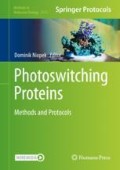Abstract
Mammalian cells can be engineered to incorporate light-responsive elements that reliably sense stimulation by light and activate endogenous pathways, such as the cAMP or Ca2+ pathway, to control gene expression. Light-inducible gene expression systems offer high spatiotemporal resolution, and are also traceless, reversible, tunable, and inexpensive. Melanopsin, a well-known representative of the animal opsins, is a G-protein-coupled receptor that triggers a Gαq-dependent signaling cascade upon activation with blue light (≈470 nm). Here, we describe how to rewire melanopsin activation by blue light to transgene expression in mammalian cells, with detailed instructions for constructing a 96-LED array platform with multiple tunable parameters for illumination of the engineered cells in multiwell plates.
Access this chapter
Tax calculation will be finalised at checkout
Purchases are for personal use only
References
Scheller L, Fussenegger M (2019) From synthetic biology to human therapy: engineered mammalian cells. Curr Opin Biotechnol 58:108–116. https://doi.org/10.1016/j.copbio.2019.02.023
Bacchus W, Lang M, El-Baba MD et al (2012) Synthetic two-way communication between mammalian cells. Nat Biotechnol 30(10):991–996. https://doi.org/10.1038/nbt.2351
Weber W, Fux C, Daoud-el Baba M et al (2002) Macrolide-based transgene control in mammalian cells and mice. Nat Biotechnol 20(9):901–907. https://doi.org/10.1038/nbt731
Weber W, Marty RR, Link N et al (2003) Conditional human VEGF-mediated vascularization in chicken embryos using a novel temperature-inducible gene regulation (TIGR) system. Nucleic Acids Res 31(12):e69. https://doi.org/10.1093/nar/gng069
Auslander D, Auslander S, Charpin-El Hamri G et al (2014) A synthetic multifunctional mammalian pH sensor and CO2 transgene-control device. Mol Cell 55(3):397–408. https://doi.org/10.1016/j.molcel.2014.06.007
Redchuk TA, Omelina ES, Chernov KG et al (2017) Near-infrared optogenetic pair for protein regulation and spectral multiplexing. Nat Chem Biol 13(6):633–639. https://doi.org/10.1038/nchembio.2343
Weber W, Rimann M, Spielmann M et al (2004) Gas-inducible transgene expression in mammalian cells and mice. Nat Biotechnol 22(11):1440–1444. https://doi.org/10.1038/nbt1021
Mansouri M, Strittmatter T, Fussenegger M (2019) Light-controlled mammalian cells and their therapeutic applications in synthetic biology. Adv Sci (Weinh) 6(1):1800952. https://doi.org/10.1002/advs.201800952
Repina NA, Rosenbloom A, Mukherjee A et al (2017) At Light speed: advances in optogenetic systems for regulating cell signaling and behavior. Annu Rev Chem Biomol Eng 8:13–39. https://doi.org/10.1146/annurev-chembioeng-060816-101254
Tischer D, Weiner OD (2014) Illuminating cell signalling with optogenetic tools. Nat Rev Mol Cell Biol 15(8):551–558. https://doi.org/10.1038/nrm3837
Ma G, Wen S, He L et al (2017) Optogenetic toolkit for precise control of calcium signaling. Cell Calcium 64:36–46. https://doi.org/10.1016/j.ceca.2017.01.004
Kolar K, Weber W (2017) Synthetic biological approaches to optogenetically control cell signaling. Curr Opin Biotechnol 47:112–119. https://doi.org/10.1016/j.copbio.2017.06.010
Muller K, Naumann S, Weber W et al (2015) Optogenetics for gene expression in mammalian cells. Biol Chem 396(2):145–152. https://doi.org/10.1515/hsz-2014-0199
Endo M, Ozawa T (2017) Strategies for development of optogenetic systems and their applications. J Photoch Photobio C 30:10–23. https://doi.org/10.1016/j.jphotochemrev.2016.10.003
Muller K, Weber W (2013) Optogenetic tools for mammalian systems. Mol BioSyst 9(4):596–608. https://doi.org/10.1039/c3mb25590e
Guru A, Post RJ, Ho YY et al (2015) Making sense of optogenetics. Int J Neuropsychopharmacol 18(11). https://doi.org/10.1093/ijnp/pyv079
Hattar S, Lucas RJ, Mrosovsky N et al (2003) Melanopsin and rod-cone photoreceptive systems account for all major accessory visual functions in mice. Nature 424(6944):76–81. https://doi.org/10.1038/nature01761
Mure LS, Hatori M, Zhu QS et al (2016) Melanopsin-encoded response properties of intrinsically photosensitive retinal ganglion cells. Neuron 90(5):1016–1027. https://doi.org/10.1016/j.neuron.2016.04.016
Ye HF, Daoud-El Baba M, Peng RW et al (2011) A synthetic optogenetic transcription device enhances blood-glucose homeostasis in mice. Science 332(6037):1565–1568. https://doi.org/10.1126/science.1203535
Zhao BX, Wang YC, Tan XH et al (2019) An optogenetic controllable T cell system for hepatocellular carcinoma immunotherapy. Theranostics 9(7):1837–1850. https://doi.org/10.7150/thno.27051
Khamo JS, Krishnamurthy VV, Chen QX et al (2019) Optogenetic delineation of receptor tyrosine kinase subcircuits in PC12 cell differentiation. Cell Chem Biol 26(3):400–410.e3. https://doi.org/10.1016/j.chembiol.2018.11.004
Auslander S, Fuchs D, Hurlemann S et al (2016) Engineering a ribozyme cleavage-induced split fluorescent aptamer complementation assay. Nucleic Acids Res 44(10). https://doi.org/10.1093/nar/gkw117
Acknowledgments
This work was supported by the European Research Council (ERC) advanced grant (ElectroGene; grant no. 785800) and in part by the National Centre of Competence in Research (NCCR) for Molecular Systems Engineering.
Author information
Authors and Affiliations
Corresponding author
Editor information
Editors and Affiliations
Rights and permissions
Copyright information
© 2020 Springer Science+Business Media, LLC, part of Springer Nature
About this protocol
Cite this protocol
Mansouri, M., Lichtenstein, S., Strittmatter, T., Buchmann, P., Fussenegger, M. (2020). Construction of a Multiwell Light-Induction Platform for Traceless Control of Gene Expression in Mammalian Cells. In: Niopek, D. (eds) Photoswitching Proteins . Methods in Molecular Biology, vol 2173. Humana, New York, NY. https://doi.org/10.1007/978-1-0716-0755-8_13
Download citation
DOI: https://doi.org/10.1007/978-1-0716-0755-8_13
Published:
Publisher Name: Humana, New York, NY
Print ISBN: 978-1-0716-0754-1
Online ISBN: 978-1-0716-0755-8
eBook Packages: Springer Protocols

